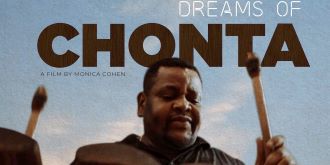
Dreams of Chonta 2020
Distributed by Pragda, 302 Bedford Ave., #136, Brooklyn, NY 11249
Produced by The Boom House/Monica Cohen
Directed by Monica Cohen
Streaming, 88 mins
College - General Adult
Folk Music; Immigration; Latin American Studies
Date Entered: 08/08/2022
Reviewed by Cindy Badilla-Melendez, University of St. Thomas, St. Paul, MNMonica Cohen’s film Dreams of Chonta documents the challenges that Afro-Colombian musician Diego Obregón endures for 12 years as an undocumented immigrant in the United States. He traveled from Cali, Colombia to New York City. His purpose was to pursue his dreams as a performer and to economically support his family back in Cali. Palma de Chonta or Chonta Palm is the wood utilized to build the marimbas in the Pacific Coast of Colombia. That is where the Chonta marimba name originates.
The film is a mixture between immigration issues and Diego’s performances of Pacific Coast music from Guapi, the closest village to the coast of Colombia, where Diego is originally from. The documentary goes back and for between scenes in New York City and Cali. Diego with no doubt is a gifted musician and yet, in order to survive, like many other undocumented immigrants, he must work in whatever he finds. You see him working in a cemetery during the day while at night doing what he loves the most, performing the chonta marimba and other instruments with his group at the Terraza club in Queens.
Cohen and her team follow Diego around and show bits of his performances, his rehearsals with other musicians, and his daily job. Friends, colleagues, and his family are interviewed. There is an interview with his 19-year-old son, Francho, who also started a music band. Here, he talks about his bond with his dad through music as well as his memories of when he was little, and his father left. He kept waiting and waiting for him. In a few sentences Francho gives a deep insight of what it feels like to be a family member of an undocumented immigrant.
Dreams of Chonta can be used for either a world music or ethnomusicology class. Also, there is a very interesting and passionate master class that Diego teaches at Berkeley College of Music. Diego introduces genres such as currulao, juga, and bunde. Having more of his performances in this film would have been very valuable for a music class. In his performances you can see and hear Colombian Pacific Coast music with chonta marimba, cununo and bombo drums. Diego also starts mixing with other non-traditional instruments such as trumpet, but still preserves the traditional music of his region.
The film feels very long and has several scenes that don’t really enrich the story, for instance what is the need to see his family in a grocery store or following Diego in the streets of Chicago various times. It could be shortened to make it more appealing for academic use. Usually, professors are looking for films that they can fit into their tight class schedules. It would have been very useful to have an introduction of who Diego was and how he contributed to the Afro-Colombian folklore music in Colombia, especially after his return to his town. Most of the documentary focuses on his life and impact in New York City’s music life. Many documentaries are offered in long or short versions. This could be a good option for this film.
There are not many videos on Afro-Latinos in general and this is becoming a very desirable topic at colleges and universities. Dreams of Chonta not only show Afro-Colombian music and an immigrant story, but it also mentions briefly about discrimination in Colombia towards the Afro-Colombian people, unfortunately not uncommon in some countries in Latin America.
This is not a typical immigration film that shows the hardship of traveling to the US via extreme dangerous areas risking people’s lives and the poverty of their families left behind. Dreams of Chonta is most suitable for courses of Latin American studies, World Music, Cultural Identity, Music Performing Arts, Immigration, Latinx, and Sociology. This film is recommended.
Awards:Oklahoma Cine Latino Film Festival: Best Sound, Music; Bare Bones Music & Documentary Festival: Best Music Doc, Best Feature Foreign Origins
Published and licensed under the Creative Commons Attribution 4.0 license. Anyone can use these reviews, so long as they comply with the terms of the license.